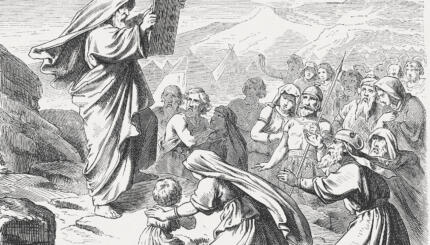The World to Come — or olam ha-bah in Hebrew — is a general Jewish term for the hereafter. References to it are sprinkled throughout ancient Jewish texts, though the particulars of what it means aren’t entirely clear.
There are two general possibilities: One is that it refers to a heavenly abode where the souls of the righteous live on after death. The other is that it’s the perfected world that will follow the coming of the messiah, when the dead are resurrected and complete peace prevails.
There are no explicit references to the World to Come in the , though some commentators saw hints to it in the text. Rabbi Chaim ibn Attar, an 18th-century Moroccan kabbalist, suggested that the Torah begins with the Hebrew letter bet — which corresponds to the number two — to hint that God actually created two worlds in Genesis, the physical world and the World to Come. And several statements in the Bible imply that there is some continuance of life that follows death in this world, including this verse from Genesis 15:15 about Abraham: “As for you, You shall go to your fathers in peace; You shall be buried at a ripe old age.” Since Abraham was not buried with his fathers, some understand this verse to be referring to the afterlife.
The first explicit mention of the World to Come appears in the , which records a number of teachings on the subject, the most famous probably being this one, from the in Sanhedrin 10:1:

Help us keep Jewish knowledge accessible to millions of people around the world.
Your donation to My Jewish Learning fuels endless journeys of Jewish discovery. With your help, My Jewish Learning can continue to provide nonstop opportunities for learning, connection and growth.
כָּל יִשְׂרָאֵל יֵשׁ לָהֶם חֵלֶק לָעוֹלָם הַבָּא
All of the Jewish people have a share in the World to Come
The mishnah immediately proceeds to detail various exceptions to this seemingly categorical statement, including those who deny the truth of the doctrine of resurrection, one who reads “external literature” (books by heretics) and whispers invocations over a wound (per Rabbi Akiva), the residents of an idolatrous city, and various biblical characters, including the king Jeoroboam and the prophet Balaam. All these and more are excluded from the World to Come.
Yet the rabbis of the Talmud don’t have a lot to say about just what the World to Come is. For that we turn to two medieval scholars who held distinct views on this question.
Maimonides was adamant that the World to Come is the reward for the righteous after death. As he describes in the Mishneh Torah:
The hidden good in store for the righteous is, life in the World to Come, which is a life connected with no death and a kind of good connected with no evil; such as is described in the Torah: “That it may be well with thee, and thou mayest prolong thy days” (Deut. 22.7), which was traditionally deducted to mean, “That it may be well with thee” in a world which is entirely good; “and that thou mayest prolong thy days”—in a world existing forever; and this is the World to Come.
Maimonides’ conception of the World to Come is akin to how many traditions imagine heaven, an eternal joyful existence of pure spirit. He goes on:
The World to Come harbors neither body nor aught of a concrete form, save only the souls of the righteous divested of body as are the ministering angels. Inasmuch as it harbors no concrete forms there is no need there for eating, drinking, or other of the bodily necessities of the sons of man in this world; neither will any of the many things which happen to bodies in this world come to pass there, as, for instance, sitting down, standing up, sleep, death, sadness, mirth or the like.
An alternate view, and one that seems to have been held by the majority of early Jewish authorities, was articulated by Nahmanides, a medieval Catalonian kabbalist and talmudist, who insisted that the World to Come is what will come into being in the present world after the messiah comes and the dead are returned to life. Nachmanides distinguishes between the World to Come, in which the physical body is present and the ancient Temple rebuilt, and the World of Souls (olam haneshamot), where the soul goes after the death of the body. Unlike Maimonides, who believed that the resurrection of the dead would be followed by a second death and the eternal rest of souls in the World to Come, Nachmanides believed the resurrected would enjoy eternal physical life in the messianic age.
Both these ideas draw support from the Talmud. In its discussion of the aforementioned mishnah about all Israel having a share in the World to Come, the Talmud explains that denial of a share in the World to Come to those who reject the resurrection is an appropriate punishment because it’s “measure for measure” — that is, commensurate with the crime. Since the denied person doubted the resurrection, they will not be resurrected themselves. Ergo, the World to Come refers to resurrection.
But Maimonides’ view that the World to Come is a place of pure spirit also draws support from the Talmud, in particular a statement from Rav recorded in the Talmud in Berakhot 17a:
The World to Come is not like this world. In the World to Come there is no eating, no drinking, no procreation, no business negotiations, no jealousy, no hatred, and no competition. Rather, the righteous sit with their crowns upon their heads, enjoying the splendor of the Divine Presence.
Though the specifics are hardly clear, that didn’t stop the ancient rabbis from saying a lot about the World to Come. Here are two of their better-known teachings on the matter, both of them from the fourth chapter of Ethics of the Fathers:
Rabbi Yaakov says: This world is like a hallway before the world to come. Fix yourself in the hallway so you may enter the drawing room.
He would say: One hour of repentance and good deeds in this world is better than all the time in the World to Come. And one hour of pleasure in the World to Come is better than all the time in this world. Pirkei Avot 4:16-17
These statements encapsulate two distinct strands of Jewish thought with respect to the World to Come. The first suggests that the World to Come is where the action is and that this world is merely a prelude, the hallway before the drawing room. The distinction is even clearer in the second teaching, which suggests that this world has intrinsic value too, and in at least one sense is superior to the World to Come — it is the place where good deeds and repentance are possible, though this idea is at least partially tempered by the claim that comes next, that the pleasures available in the World to Come are simply unimaginable. The latter point is reflected in another famous dictum about the World to Come, from Tractate Berakhot 57b, which teaches that Shabbat is one-sixtieth of the World to Come — that is, the joy of Shabbat is but a hint of the vastly greater pleasures that await the righteous.
References to the World to Come show up with much greater frequency in and mystical works. The medieval Spanish kabbalist Abraham Abulafia penned an entire volume entitled Chayei Olam Habah (“The Life of the World to Come”), though that work is primarily concerned with meditation techniques that enable a direct experience of God. Rabbi Moshe Hayyim Luzzatto, an 18th century kabbalist and the author of one of the core texts of Mussar, or Jewish character development, echoed the first teaching from Ethics of the Father noted above in claiming that the work of this world is merely to prepare for the next. In his major work, The Path of the Just, he writes:
It is the foundation of saintliness and the perfect worship of God for a man to realize what constitutes his duty in his world and to which aim he is required to direct all his endeavors throughout his life. Now our sages, of blessed memory, have taught us that man was created only to find delight in the Lord and to bask in the radiance of His Shekhinah [divine presence] for this is the true happiness and the greatest of all possible delights. The real place in which such delight can be attained is the World to Come, for this has been prepared to this very purpose. But the way to attain this desired goal is this world.
In contemporary times, Jewish thinkers tend not to focus too much on the World to Come. Among liberal Jews, the concept veers into theological beliefs that many do not accept. According to the Pew Research Center, Jews have among the lowest rates of belief in heaven and hell among all American religious groups. Among more traditionally observant Jews, the concept gets somewhat greater air time. A 2019 volume of teachings on the World to Come by Rabbi Avigdor Miller, a prominent American haredi rabbi who died in 2001, made the case that the concept is not given sufficient attention in the Orthodox community.
Gemara
Pronounced: guh-MAHR-uh, Origin: Aramaic, a compendium of rabbinic writings and discussions from the first few centuries of the Common Era. The Talmud comprises Gemara and the Mishnah, a code of law on which the Gemara elaborates.

Help us keep Jewish knowledge accessible to millions of people around the world.
Your donation to My Jewish Learning fuels endless journeys of Jewish discovery. With your help, My Jewish Learning can continue to provide nonstop opportunities for learning, connection and growth.



